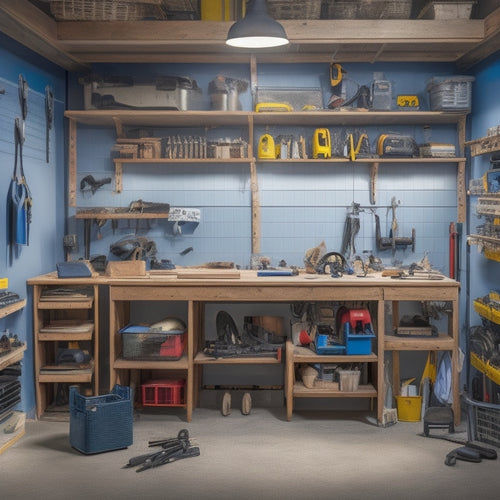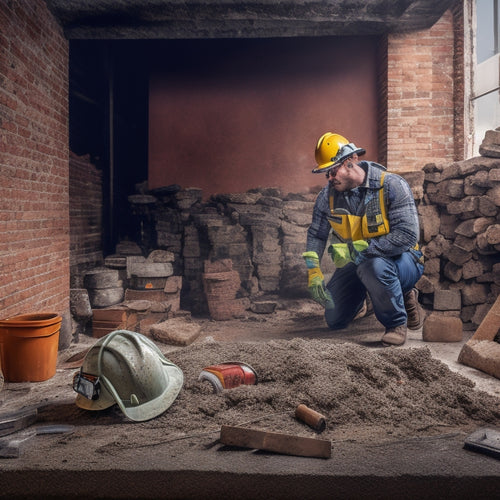
5 Must-Have Plastering Tools for Safe Renovation
Share
You'll need a range of essential tools to tackle your plastering project safely. Invest in a variety of trowels, including putty knives for applying plaster, joint knives for smoothing joints, and finishing trowels for a smooth surface. Protect yourself with personal protective equipment (PPE) like a dust mask, safety glasses, and gloves. Use ergonomic techniques, such as taking regular breaks, and keep your workspace clean and organized. Other must-haves include safety goggles, a sturdy mixing bucket, and non-slip mats to prevent falls and trips. Knowing these essentials is just the start to a safe and successful plastering renovation project.
Key Takeaways
• Invest in a variety of trowel types, including putty knives, joint knives, and finishing trowels for optimal results.
• Use personal protective equipment like dust masks, safety glasses, and gloves for protection from dust and debris.
• Choose ergonomic tools with comfortable handles to reduce fatigue and prevent injuries.
• Select a sturdy mixing bucket that can withstand the weight of mixed plaster and prevent spills.
• Ensure good ventilation and wear a dust mask or respirator when mixing and sanding plaster.
Essential Plastering Hand Tools
You'll need a set of reliable, high-quality hand tools to tackle plastering tasks efficiently and safely. Having the right tools at your disposal can make all the difference in achieving professional-looking results.
When it comes to plastering, the right trowel can be your best friend. There are several trowel types to choose from, including putty knives, joint knives, and finishing trowels. Each has its own specific purpose and is designed for a particular stage of the plastering process.
For example, putty knives are ideal for applying and spreading plaster, while joint knives are perfect for smoothing and finishing joints. Finishing trowels, on the other hand, are used to create a smooth, even surface.
Mastering various finishing techniques, such as knocking down and applying textures, can also elevate your plastering game. By investing in a quality set of hand tools and honing your skills, you'll be able to tackle even the most complex plastering tasks with confidence and precision.
With the right tools and techniques at your disposal, you'll be free to create beautiful, professional-looking finishes that will make your renovation project stand out.
Protecting Yourself at Work
Wearing personal protective equipment (PPE) is vital when working with plaster, as it can help prevent injuries from dust, debris, and other hazards that are inherent to the plastering process. You should always wear a dust mask or respirator, safety glasses, and gloves to protect yourself from the physical demands of plastering.
Additionally, consider wearing a long-sleeved shirt, pants, and closed-toe shoes to prevent skin irritation and injuries from sharp objects.
To further protect yourself, incorporate ergonomic techniques into your work routine. This includes taking regular breaks to stretch and move around, as well as using tools with ergonomic handles that reduce strain on your hands and wrists.
Proper workspace organization is also essential, as it can help prevent tripping hazards and reduce the risk of accidents. Keep your workspace clean and clutter-free, and make sure that all tools and materials are within easy reach.
Mixing and Applying Safely
When mixing and applying plaster, it's crucial to follow established safety protocols to minimize exposure to hazardous materials and prevent accidents.
As you work with plaster, you'll need to employ proper mixing techniques and application methods to guarantee a safe and successful renovation.
Here are some key considerations to keep in mind when mixing and applying plaster:
-
Use a well-ventilated area to prevent inhalation of dust and particles.
-
Wear a dust mask or respirator when mixing or sanding plaster.
-
Use a mixing bucket with a sturdy handle to prevent spills and splashes.
-
Apply plaster in thin layers to prevent excessive weight and stress on the surface.
-
Use a level to verify a smooth, even application.
Essential Safety Wear Items
Adequate protective gear is essential for minimizing risks associated with plastering, and several important safety wear items should be part of your standard kit.
When working with plaster, you're exposed to various hazards, including flying particles, dust, and chemicals. To protect your eyes, safety goggles are a must-have. They should be worn whenever you're mixing or applying plaster, as well as when sanding or drilling. Look for goggles that provide a snug fit and have a good seal around your eyes to prevent debris from entering.
In addition to safety goggles, dust masks are another important safety wear item. Plastering can generate a considerable amount of dust, which can cause respiratory problems if inhaled. A dust mask will help filter out airborne particles, ensuring you can breathe easily while working. Choose a mask that fits comfortably and has a filter designed for fine dust particles.
Preventing Falls and Trips
Many plastering tasks require working at heights or maneuvering through cluttered workspaces, so it's crucial you take steps to prevent falls and trips that can lead to serious injuries.
As you plan your renovation project, consider the site layout and identify potential hazards that could lead to accidents. Proper hazard identification is key to preventing falls and trips.
To guarantee a safe working environment, make sure to:
-
Clear the workspace of clutter and tripping hazards
-
Use scaffolding or ladders safely and securely
-
Install handrails and guardrails where necessary
-
Ensure good lighting in the workspace
-
Use non-slip mats or coatings on floors and scaffolding
Frequently Asked Questions
What Is the Ideal Storage Method for Plastering Tools?
When it comes to storing your tools, you're looking for a method that keeps them organized, protected, and within reach.
Effective tool organization is key to a smooth workflow. You'll want to invest in storage solutions that are sturdy, adjustable, and easy to clean.
Consider a pegboard or a modular storage system that can be customized to fit your specific toolset. This will free you up to focus on the task at hand.
Can I Use Regular Gloves for Plastering Work?
'Don't be caught with your hands down' when it comes to protecting yourself from harsh plastering chemicals and rough surfaces.
You're wise to question whether regular gloves will cut it for plastering work. The answer is no.
You need gloves specifically designed for plastering, meeting safety standards like EN374 and EN388.
Look for gloves with resistant materials, grip, and durability. Regular gloves won't provide the same level of protection, putting your hands at risk.
How Often Should I Inspect My Plastering Equipment?
You're wise to prioritize equipment longevity by inspecting your gear regularly.
For plastering equipment, it's essential to check for wear and tear every 1-3 months, depending on usage.
Look for signs of damage, corrosion, or excessive wear on tools like trowels, hawks, and mixing equipment.
Regular inspections will help you identify potential issues before they become major problems, ensuring your safety and freedom to work efficiently.
Can I Plaster Over Existing Wallpaper Safely?
When deciding to plaster over existing wallpaper, you're taking a risk. To do it safely, you must guarantee the wallpaper is securely attached and won't peel off with the new plaster.
You'll need to use specialized wallpaper removal techniques or surface preparation methods to create a stable base. Scrape off loose paper, clean the area, and apply a bonding agent to create a strong bond between the old and new surfaces.
Are There Any Eco-Friendly Plastering Tool Options?
You're wisely considering the environmental impact of your plastering tools.
In your pursuit of eco-friendly options, you'll be pleased to know that many manufacturers are now offering sustainable materials and biodegradable alternatives.
Look for tools with handles made from reclaimed wood or bamboo, and blades crafted from recycled metals.
Some companies even offer biodegradable plastering brushes made from natural fibers.
Conclusion
You're the master builder, constructing a safe renovation site. Just as a strong foundation supports a sturdy structure, the right plastering tools guarantee a secure and successful project.
Your safety gear is the armor that shields you from harm, while your essential hand tools are the skilled craftsmen that get the job done.
With the right mix of preparation and protection, you'll be the architect of a flawless renovation, where accidents are just a blueprint of the past.
Related Posts
-

Why Home Renovators Need Smart Tool Storage Now
You need a smart tool storage system that streamlines your workflow, reduces clutter, and protects your investments b...
-

7 Must-Have Safety Gears for Brick Wall Renovation
When renovating a brick wall, you'll face a multitude of hazards, making it essential to wear and use the right safet...
-

Streamline Your Exterior Renovation Timeline
To streamline your exterior renovation timeline, you'll need to approach the process strategically. Start by planning...


